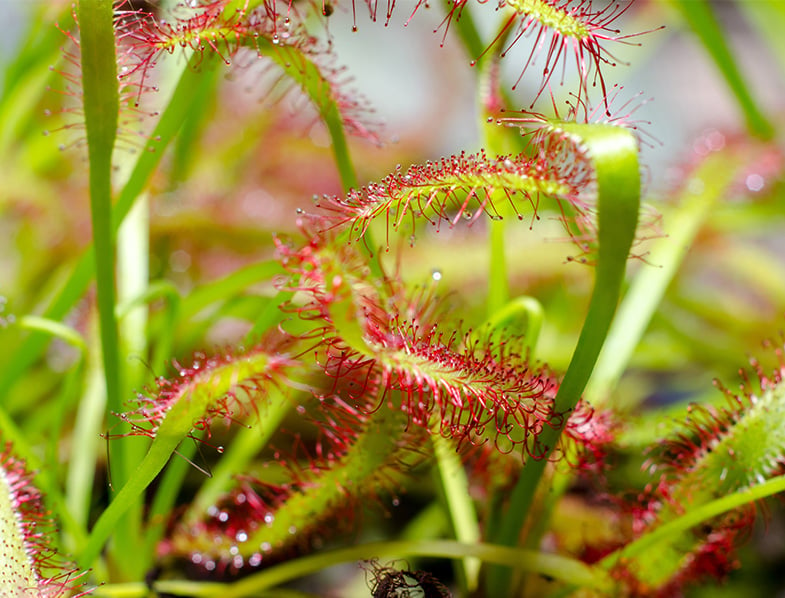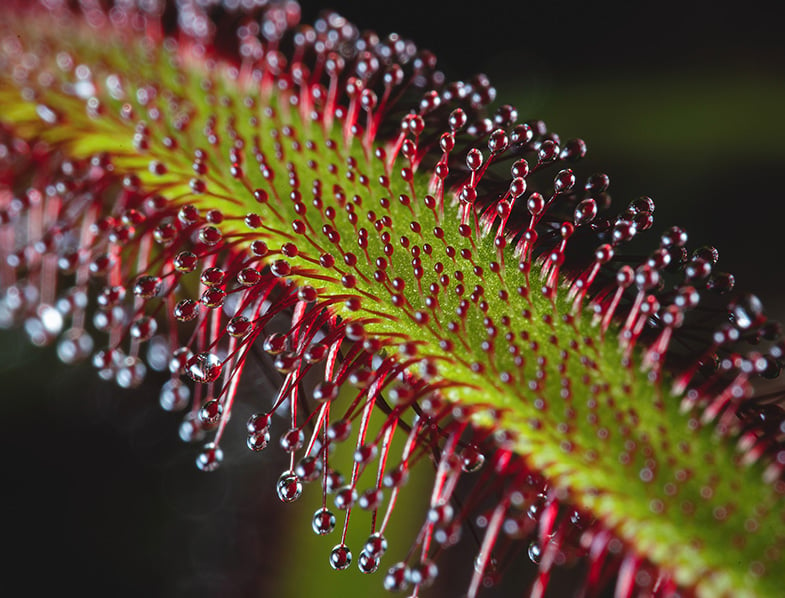The cape sundew isn’t your average indoor houseplant. While it does offer a unique look, there’s something that’s even more interesting about it: it’s carnivorous.
That’s right, this plant prey, trap, and feed on the meat of insects. Cool (or creepy) right? If you’re looking for a houseplant that will be sure to garner a lot of attention and will add interest to your home, a cape sundew will be sure to get the job done.
As a carnivorous tropical plant, the cape sundew does require care that is different from the care that other houseplants need. In order to ensure that you are providing it with the care that it needs, read on for more information. From feeding to light requirements, and from watering to lighting needs, below, you’ll find out everything you need to know to properly tend to the interesting cape sundew.

Cape Sundew: An Overview
Before we dive in and discuss how to grow and care for a cape sundew, we want to provide you with a brief overview of this plant. We find that having a better understanding for a plant creates a deeper connection with it, and thus, means that gardeners will tend to it with greater care.
- The cape sundew, as mentioned, is a genus of carnivorous plants. To date, there are more than 200 known species of sundews. Some of the qualities of this plant are similar to other sundews and species of carnivorous plants, but some are unique to the cape sundew.
- A perennial plant that is native to the Cape of South Africa (hence the name), the cape sundew grows small rosettes and features sticky leaves with vibrantly colored tentacles to lure small bugs and insects. Once its pray lands on the leaves, they’re trapped by the sticky substance that it produces. The leaves then roll up lengthwise toward the middle, which allows the digestive glands of the plant to come into contact with the insect or bug. The digestion process takes approximately 6 hours to complete from the time the pray first becomes trapped on the plant.
- As a perennial, herbaceous plant, the cape sundew lacks a persistent woody above-ground stem. It’s relatively small in size, only growing to about 3 inches tall.
- It produces a small rosette, and the leaves of this plant are covered with tiny red hairs that secrete a sticky liquid and are reddish in color.
- It flowers during the summer months, and as the temperatures grow warmer, it can produce rows of numerous flowers that grow along the stalk.
- The blooms resemble a viola and can range in color from white to pale pink, and even violet. They also produce a sweet, yet delicate scent, which lures in its prey.
Compared to other varieties of sundews, the cape sundew is fairly easy to grow, care for, and propagate. The unique beauty and the fact that it is carnivorous, are sure to make this plant an interesting addition to any indoor garden.

How to Grow & Care for a Cape Sundew
While it is one of more than 200 species of sundews, the cape sundew has unique care requirements. Below, you’ll find out everything you need to know about properly planting and caring for this plant so that it will thrive and provide enjoyment for years to come.
Soil Requirements
The cape sundew does best in a sandy peat moss soil mix, or a mixture of 50 percent peat moss and 50 percent horticulture sand. They do not rely much on nutrients from the soil, as the plant obtains most of the nutrition that it requires from the prey it consumes.
Additionally, it should not be fertilized, as again, it gets the nutrition that is needed from the bugs and insects it feeds on. In fact, fertilizing the plant can actually end up burning the roots and could potentially kill your cape sundew.

Because the cape sundew is a carnivorous plant, in lieu of fertilizer, it should be fed insects, such as flies and spiders. If you live in a warm climate that can support a sundew plant, you can leave it outside, where it will feed itself. If you live in a cooler climate, it should be left inside, where it will rely on you to feed it.
It can consume flies, spiders, ants, moths, fruit flies, and gnats. If you are unable to locate live insects, you can feed the plant freeze dried bugs, such as fly larvae. When feeding freeze dried insects, mix them in water first. Doing so will make the insects softer and easier to digest.
The cape sundew only needs to be feed about once a week, on average. A word of caution: make sure that the insects the cape sundew is fed have not been exposed to insecticides, as they chemicals are toxic and could potentially kill the plant. Also, avoid overfeeding, as doing so could potentially kill the plant.
Light Requirements
The cape sundew thrives in full sun to part shade and will produce the most vibrant colors when they are exposed to such conditions. If they are kept as a houseplant, placing it in a window that receives ample amounts of sunlight is ideal. If necessary, you can also use artificial light to provide the cape sundew with the light that it needs to thrive.
Water Requirements
The watering requirements of a cape sundew are similar to those of other carnivorous plants. The soil should be kept evenly moist; however, it should not be soaked. To determine when it needs to be watered, feel the soil. If the first inch or so of the soil feels dry, the plant needs to be watered.
An important note: avoid using tap water, as it can contain salts and chlorine that could be harmful to the plant; instead, use rainwater, purified water, or distilled water.
- Live healthy adult sized Drosera capensis (cape sundew)
- Comes with 3 inch pot
- Comes with enough New Zealand sphagnum moss to fill pot
- Comes with detailed care sheet & growing instructions
- Shipped bareroot
- LIVE ADULT PLANTS: Each plant is fully grown and comes with a live arrival .
- NO SOIL REQUIRED: Each plant is shipped in sphagnum moss or with enough moss to pack the pot.
- UNIQUE POTTED PLANTS: Grow in a sunny windowsill, bright bathroom, greenhouse, or terrarium/vivarium
- GREAT CHRISTMAS OR BIRTHDAY GIFTS: These plants make cool gifts for men, women, boys, and girls.
- CARNIVOROUS SUNDEW PLANTS: Each leaf can make sticky droplets that glisten in the sun.
- Cape Sundew 'Alba' (Drosera Capensis) is a carnivorous plant that uses the sticky droplets on its leaves to catch insects.
- WATER: Use rainwater. If rainwater is not available you can use distilled water. Do not let the medium dry out.
- LIGHT: Full sun.
- HUMIDITY: Moderate to high (above 50% relative humidity).
- SOIL: The medium should be free of nutrients and allows good drainage. Use a mixture of 1 part sphagnum peat moss and 1 part perlite.
Last update on 2024-10-03 / Affiliate links / Images from Amazon Product Advertising API
Repotting
As long as the pot is large enough, the cape sundew does not need to be transplanted; however, if, initially, it was housed in a small planter, you can repot it into a larger one. Only do so if the plant starts to overgrow the pot. Spring is the ideal time for repotting.
Grooming and Maintenance
In addition to the interesting look and nature of this carnivorous plant, the cape sundew does not require much care. With that said, however, while it is relatively easy to care for, it does require a bit of maintenance.
Once the leaves and flowers wither, you can remove them from the stems in order to keep the plant healthy and attractive. Otherwise, than removing spent foliage, it really does need any other grooming or maintenance.
Propagating a Cape Sundew
The cape sundew produces generous amounts of seeds, so it is a pretty easy plant to propagate. Simply collect the seeds and sow them in a propagating tray. Place the tray in a partially shade location and moisten the soil with purified water.
Make sure to maintain the temperature of the room between 70 degrees and 75 degrees F. When the seedlings have grown to a large enough side and they can safely be transplanted ,move them into their own pots filled with sphagnum moss or a sandy peat soil.
Summing It Up
If you’re looking for an interesting an unexpected plant to add to your indoor garden, the cape sundew is an excellent choice. It’s visually appealing, produces a mild scent, and the fact that it’s carnivorous will certainly provide some entertainment. With the tips presented above, you should be able to easily care for this unique houseplant.




1 Comment
I have what looks like thin blades of grass growing in the pit with my sundew.
It is in sphagnum moss. Is this grass or some sort of weed that I need to take out or is it part of the sundew?
Tia!